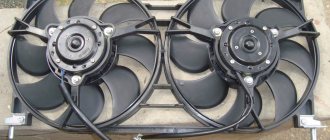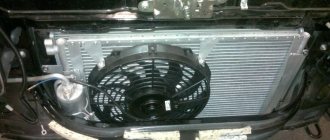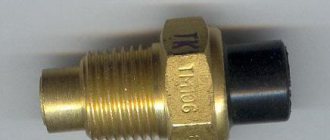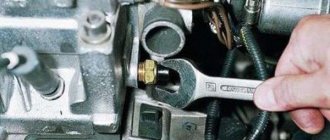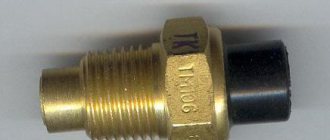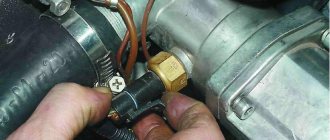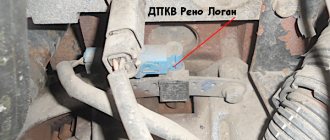The fan switching sensor is an element of the carburetor engine cooling system (2108, 21081, 21083) of VAZ 2108, 2109, 21099 cars. Purpose of the fan switching sensor
The fan switch on in the cooling system of a carburetor engine is designed to turn on or off depending on the coolant temperature of the fan on the radiator.
Location by car
The fan switch sensor is screwed into the threaded hole of the right (in the direction of the car) radiator cooling tank.
Fan sensor device
The sensor body is made of brass or bronze. This is an oblong cylindrical cylinder with a nut at the top, a thread in the middle, and a flat surface at the bottom. The connection between the sensor and the radiator is sealed with an aluminum or copper O-ring. The sensor has two outputs: one current is supplied (minus), the other goes to the fan switch relay (113.3747) in the mounting block (also minus). Inside the housing, the leads have two contacts. There is also a bimetallic plate located inside the case (attached to the bottom); as it heats up, it changes its curvature and closes the contacts.
Operating principle of the fan switch sensor
On VAZ 2108, 2109, 21099 cars until 1998. with mounting fuse block 17.3722 (finger type fuses).
The fan switch sensor is installed in the gap in the negative wire leading to the fan switch relay in the mounting block. When the temperature in the radiator of the cooling system rises to 99±3º C, the contacts inside the fan switch sensor are closed by a bimetallic plate, and an electric current (minus) flows through it to a relay in the mounting block. From the relay, the current (already a plus) goes to the electric motor of the fan on the radiator and turns it on.
On VAZ 2108, 2109, 21099 cars after 1998. with mounting blocks 2114, the fan switch relay is removed from the electrical circuit. The fan switch sensor is also installed in the gap of the negative wire, but this time goes directly to the fan. The contact closure temperature is similar.
If the temperature in the radiator drops below 93±3º C, the bimetallic plate opens the contacts and the fan electric motor is de-energized.
Malfunction of the fan switch sensor
The fan switch sensor rarely fails, since there is practically nothing to break there. The reasons for its failure may be poor workmanship or mechanical deformation. If you have problems turning on the fan on the radiator, you should first check its electrical connections. Having removed both wires from the sensor, we connect them together. Turn on the ignition. If the fan starts working, the on/off sensor is faulty. If not, the fault should be sought in other elements of the circuit.
Applicability of the fan switch sensor
The cooling system of the carburetor engine of VAZ 2108, 2109, 21099 cars uses the TM 108 sensor with markings on the body “99-94”. It works both through a relay in the mounting block in cars before 1998, and without a relay in cars of later years. Analogues of this sensor from different manufacturers are also available for sale.
Notes and additions
— On the injection engine of VAZ 2108, 2109, 21099 cars, the cooling system fan is turned on at the command of the control unit (ECU), which analyzes the readings of the coolant temperature sensor (DTOS).
— There is another temperature sensor in the cooling system of carburetor and injection engines of VAZ 2108, 2109, 21099 cars. This is the temperature indicator sensor in the instrument panel (TM 106). It only works on the temperature indicator.
More articles on the engine cooling system of VAZ 2108, 2109, 21099 cars
The essence of the post is already visible in the title. So the question is - why does the fan come on late?
A friend advised me to replace the temperature sensor, the one located near the thermostat.
Sensor for turning on the fan of a VAZ 2109 car
The VAZ-2109 fan switching sensor (DVV) is the most important part for ensuring safe engine operation.
During a long period of driving the car in a low gear or parking with the engine running, the radiator begins to fail to cope with its main function. Strongly heated coolant (coolant) moving inside it can boil. To prevent this from happening, the DVV turns on the electric fan (EV), and the temperature in the cooling system returns to normal. Fan switch sensor:
Controller diagnostics
To diagnose the controller, you will need a calibrated thermometer that can operate at the boiling point of water. The diagnostic procedure is carried out as follows:
- Often the sensor facing the inside of the radiator should be placed in water.
- Next, the tester probes are connected to the controller contacts, and they are adjusted to ensure there is no resistance.
- When the liquid begins to heat up, the resistance disappears at approximately 87-92 degrees. If so, then the controller is healthy and will work as expected.
The VAZ 2107 fan switch sensor is responsible for the timely switching on of the radiator fan, which prevents the possibility of engine overheating when driving at low speed and in other conditions when natural airflow is not enough for effective cooling. Otherwise, the antifreeze may boil and even cause engine damage.
Spare part device
This sensor is installed on VAZ-2108, 2109 and 21099 cars with a carburetor. The part is a brass or bronze cylinder with a nut skirt. In its upper part there is a plastic cup, inside of which there are two terminals. One input (minus) and the second output (plus). The DVV is connected to the break in the negative wire leading to the electric fan relay.
Under the nut there is a thread with which the device is screwed into the seat on the radiator. An aluminum or copper sealing ring is placed on the thread. At the bottom of the case there is a bimetallic plate that rests on the bottom terminal.
Sensor internals:
It should be noted that after 2004, when the VAZ-2108, 2109 and 21099 models were released, an injector began to be installed on the engine instead of a carburetor. The use of DVV has ceased to be relevant, since the electronic control unit (ECU) has become involved in rotating the propeller.
DIY repair
To carry out repairs yourself, you need to use the following tools:
- a Phillips head screwdriver;
- 10mm wrench.
When dismantling, you need to remove the plastic trim, which is located on the outside of the windshield. To remove it, you need to open the hood and remove the 5 bolts that secure the trim to the body. Remove the rubber seal from the engine compartment and pry the casing with a screwdriver to get to the motor and oven fan. Now you can remove the motor. It is attached to the body of the VAZ 2108 with two bolts.
When the clamps are disconnected, you can turn off the power and disconnect the positive wire of the furnace under the dashboard. The negative one is attached over a special thread and pressed down with a special nut. You need to unscrew the nut by touch and fold back the negative wire. By disconnecting the wires, you can remove the motor and install a new fan. The entire structure is assembled in reverse order.
It is important to note that breakdowns associated with the stove also depend on which panel is installed on the VAZ - low or high. Both have their downsides
For example, on a high one the central flap does not open completely. It is she who is responsible for supplying cold and hot air to the car interior. To solve this, you need to adjust the damper. And to get to it you need to disassemble the dashboard.
If we talk about the low panel, this is where the thermostat often breaks. Of course, if it wears out, the oven will not work. It is recommended to change it every two or three years. And if replacement does not solve the problems, it is worth replacing the hoses that connect the stove and radiator.
Principle of operation
The critical threshold for heating the coolant of a running engine is t = 99 °C. Until this mark is reached, the bimetallic strip is in a bent state, without touching only one of the two contacts. With further heating, the plate unbends, closing the sensor contacts. Current passes through the terminals and the electric motor relay is activated. When the antifreeze cools in the large circuit of the engine cooling system, the reverse process occurs in the sensor. The bimetal opens the contacts and the propeller blades stop rotating.
Control circuit modernization
The cooling fan on the top ten turns on at a temperature of 100-105°C, while the normal operating temperature of the engine is 85-90°C, so the fan turns on when the engine overheats, which naturally has a negative effect.
This problem can be solved in two ways: adjust the switch-on temperature in the “brains” or make a button. We'll focus on the second one. Turning on the fan from the button is very convenient: if you get into a traffic jam, turn it on, drive out, turn it off, and no overheating occurs.
A button for selecting the fan operating mode was installed in the cabin (always off, constantly on, automatically turned on via a sensor) - this “tuning” is not mandatory, but will be a very useful addition.
There will be a large current at relay contacts 87, 30, on the wire from the battery to the fuse and the fan ground, and therefore we must use wires there with a cross-section of at least 2 mm, otherwise the thinner wire will not withstand it and will burn out.
Checking the functionality of the DVV
The way to check the fan switch sensor is quite simple. It consists of disconnecting the electric motor cable from the DVV terminals. By turning the key, the ignition is turned on, and the cable wires are connected to each other (this can be done with a regular screwdriver). If the blades begin to rotate, then the problem is in the sensor itself. It cannot be repaired and is replaced with a new part. Otherwise, the breakdown must be looked for in the cable or in the electric motor.
A little theory
Characteristic
Explanation
The sensor is located in the heater radiator. It is not difficult to determine that this is the one in front of you, since in the radiator it is the only element to which the wires are connected. And if you take a 30 key, then only the sensor has the appropriate fastener size.
Sensors may have different temperature limits. But for the VAZ 2114, switching on occurs at 102-105 degrees Celsius, and switching off occurs at 85-87 degrees. When choosing a new meter, focus on the one that has failed, or purchase one with an on and off indicator of 102 and 87 degrees, respectively
There is a special contact group inside the sensor. When the coolant in the radiator heats up, this group heats up and expands. When the expansion reaches a certain limit, the contacts close, they transmit a signal to the wiring and the fan turns on
Replacing DVV
To install a new EV switch on sensor, proceed as follows.
- The car is driven into a pit.
- Remove the negative terminal from the battery.
- Unscrew the cap of the expansion tank.
- Place some clean container under the engine.
- After unscrewing the bolt from the engine block, drain the antifreeze into a container.
- Remove the cable plug from the DVV terminals.
- Unscrew the sensor using a 19-mm open-end or socket wrench.
- A new device is installed in its place.
- The EV cable block is secured to the terminals of the new sensor.
- After removing the cap, antifreeze is poured into the radiator neck until the antifreeze level in the expansion tank is between o and “max”.
- Start the engine and monitor the coolant temperature dial indicator. When the arrow approaches the red zone, the fan should turn on.
At the first overheating of the VAZ-2109 engine, you must stop driving and let the engine cool. You need to slowly drive home, watching the coolant temperature gauge along the way. If the DVV breaks down, remove the fan motor cable from the sensor and short-circuit its wires directly. This way, you can return to the garage without letting the antifreeze boil.
see also
Comments 60
It always shows like this for me. I set the BC to 95 degrees and everything is fine
The expansion tank cap solved everything))
in the brain it is written to turn on the fan somewhere around 100-103 (personally, the electronic instrument shows me the 103 limit and it turns off at 98 degrees. As an option, re-flash the brains or buy an on-board vehicle with a “safari” function, something like that_ in general, the gist there is this , it is possible to change the temperature at which the fan turns on through it... the sensors are all the same, there is no difference _ it will turn on at the same temperature)))
Thanks for the advice, that's what I'll do)
This is a normal temperature, on all Eng 09 the ventilator turns on like this, don’t worry, it was 2 09 and on both of them it’s like that
They are simply afraid that the cylinder head will lead)))
Don’t suffer from bullshit, don’t interfere with the car’s work, everything is fine with your temperature)
I also want to think so, but the rising coolant level in the expansion tank does not give me peace of mind)))
I don’t know, I’ve been driving like this for a long time and in more than one car, a friend’s 9 does the same thing) and the flight is normal, it’s warm in winter)
How to replace the fan switch sensor on a VAZ 2108-VAZ 21099?
Removal: 1) First, drain all coolant from the radiator. (For how to drain the fluid, see the article: “Replacing Coolant”)
Note! It is not always necessary to drain the coolant from the radiator; if you have sufficient skill in replacing the sensor, you can do this:
• First, disconnect two wires from the old sensor and then unscrew the sensor from the hole, and immediately install a new sensor in its place, and connect the same two wires to it, thanks to this operation, a very small amount of liquid will pour out of the radiator, and thus the sensor will be replaced with a new one. (How to unscrew the sensor and disconnect two wires from it, see below in the same article)
2) Next, find this same sensor on the radiator, and then use your hands to disconnect the two wires that are connected to it.
Note! To be 100% sure that the fan switch sensor has actually become unusable, do the following:
• After disconnecting the two wires from the sensor, touch their bare ends together and the fan should start working.
Note! If your fan actually started working after closing these two wires, then this means that the sensor has become unusable, but if the fan does not work, then in this case the whole problem is in itself, namely in the fan electric motor, replace the electric motor with a new one, and after which the problem should disappear! (For how to remove the electric motor, see the article “Replacing the Radiator Fan”)
3) Now loosen the nut that secures the “-” terminal to the battery, and then remove it. (For details on removing the terminal, see the article: “Replacing the battery”, point “1”)
4) Then, using a wrench, completely unscrew the sensor from the hole in which it is located.
Note! Turn out the old sensor carefully, because on its thread there is also a sealing gasket installed, which can also be installed on the thread of the new sensor!
Installation: 1) First, pick up the new fan switch sensor, and then install it into the radiator hole, and after installation, use a wrench to tighten the sensor nut until it stops.
2) Next, connect the two ends of the wires to the sensor.
3) Next, place the “-” terminal on the battery, and then tighten the nut that secures it.
4) And at the end of the operation, fill the cooling radiator with coolant. (How to add fluid, see the article: “Replacing coolant”)
Source
How to balance an impeller
There are two balancing options:
- The first is to twist a thin wire onto the fan blade. See on which side the imbalance is more pronounced. Try to align the impeller with a smooth movement until the extraneous sounds disappear.
- The second is to insert an axis into the hole, the diameter of which is similar to the diameter of the hole. Install the impeller on two supports located in a horizontal position. If there is an imbalance, you can get rid of it by grinding a heavier blade, or by gluing a small weight to a blade with less mass.
You can replace the four-blade impeller (this is a standard part) with an eight-blade one.
On sale you can find both individual impellers and complete with a motor. The latter, naturally, are much more expensive. Therefore, you should not choose the second option if the motor is working properly (usually it just needs to be lubricated so that it works better). You should not buy the cheapest impellers. They usually have minor defects.
Fan activation sensor VAZ 21099 injector
The fan switching sensor is an element of the carburetor engine cooling system (2108, 21081, 21083) of VAZ 2108, 2109, 21099 cars.
Purpose of the fan switching sensor
The fan switch on in the cooling system of a carburetor engine is designed to turn on or off depending on the coolant temperature of the fan on the radiator.
Location by car
The fan switch sensor is screwed into the threaded hole of the right (in the direction of the car) radiator cooling tank.
Fan sensor device
The sensor body is made of brass or bronze. This is an oblong cylindrical cylinder with a nut at the top, a thread in the middle, and a flat surface at the bottom. The connection between the sensor and the radiator is sealed with an aluminum or copper O-ring. The sensor has two outputs: one current is supplied (minus), the other goes to the fan switch relay (113.3747) in the mounting block (also minus). Inside the housing, the leads have two contacts. There is also a bimetallic plate located inside the case (attached to the bottom); as it heats up, it changes its curvature and closes the contacts.
Operating principle of the fan switch sensor
On VAZ 2108, 2109, 21099 cars until 1998. with mounting fuse block 17.3722 (finger type fuses).
The fan switch sensor is installed in the gap in the negative wire leading to the fan switch relay in the mounting block. When the temperature in the radiator of the cooling system rises to 99±3º C, the contacts inside the fan switch sensor are closed by a bimetallic plate, and an electric current (minus) flows through it to a relay in the mounting block. From the relay, the current (already a plus) goes to the electric motor of the fan on the radiator and turns it on.
On VAZ 2108, 2109, 21099 cars after 1998. with mounting blocks 2114, the fan switch relay is removed from the electrical circuit. The fan switch sensor is also installed in the gap of the negative wire, but this time goes directly to the fan. The contact closure temperature is similar.
If the cooling fan does not work
To drive the fan, a DC electric motor with excitation from permanent magnets ME-272 or similar is installed. Technical data of the electric fan and fan switch sensor:
- Rated rotation speed of the electric motor shaft with impeller, 2500 – 2800 rpm.
- Electric motor current consumption, 14 A
- Sensor contact closure temperature, 82±2 degrees.
- Sensor contact opening temperature, 87±2 degrees.
The cooling system fan may not turn on due to:
- electric drive malfunctions;
- blown fuse;
- faulty thermostat;
- a failed thermal sensor for turning on the cooler;
- faulty VO relay;
- broken electrical wiring;
- faulty expansion tank plug.
To check the VAZ fan electric motor itself, we apply 12 V voltage from the battery to its terminals - a working motor will work. If the problem is with the fan, you can try to repair it. The problem is usually the brushes or bearings. But it happens that the electric motor fails due to a short circuit or break in the windings. In such cases, it is better to replace the entire drive.
The BO fuse is located in the mounting block of the car's engine compartment and is designated F7 (20 A). The test is carried out using a car tester turned on in probe mode.
- In a car with a carburetor engine, you need to check the sensor - turn on the ignition and short-circuit the two wires going to the sensor. The fan should turn on. If this does not happen, the problem is definitely not with the sensor.
- For injection cars, it is necessary to warm up the engine to operating temperature and disconnect the sensor connector, disconnecting it from the vehicle’s on-board network. In this case, the controller must start the fan in emergency mode. The electronic unit perceives this as a failure in the cooling system and forces the fan drive to operate in constant mode. If the drive starts, the sensor is faulty.
Coolant temperature sensor for VAZ 2109 and 21099 cars
First, it is advisable to know where the engine temperature sensor is located. On models 2108, 21099 and VAZ 2109, the coolant temperature sensor is installed between the cylinder head and the thermostat, in the exhaust pipe.
Device and principle of operation
The engine temperature controller itself is a thermistor-resistor device characterized by a negative temperature coefficient. The resistance parameter itself can be measured only when the temperature decreases or increases.
When the power unit heats up as a result of operation, the resistance indicator decreases; if the engine cools down, this parameter increases. For example, at the operating temperature of the engine on a VAZ 2109, the resistance is equal to 180 Ohms, and if it is 40 degrees cold outside, then the resistance will be equal to 100,700 Ohms. On one side of the DTOZH VAZ 2109 injector there are two contacts, and on the other there is a sensitive component, which is located directly in the flow of consumables.
As for the principle of operation, when the driver turns on the ignition, the control unit transmits voltage to the regulator via a resistor. Since the DTOZH itself is a thermistor, the voltage supplied from the control unit changes immediately taking into account the temperature of the consumable. When the parameter decreases, the unit analyzes the temperature and, in accordance with these data, determines the required volume of gasoline for injection. As the power unit warms up, the volume of gasoline that is transferred to the cylinders will decrease.
Two antifreeze temperature sensors for VAZ
In addition to starting, according to the readings of the regulator, the ECU adjusts the operation of the power unit at idle speed. As a result, he independently makes decisions on enriching the combustible mixture at high and medium loads on the internal combustion engine. This indicator can be changed depending on the ignition timing.
There are two temperature sensors on a carburetor car. One turns on the fan, the other is responsible for indicating the temperature on the dashboard.
Possible faults
There are several reasons why the regulator on the VAZ 21099 refuses to work.
So, why DTOZH does not work:
- An electrical contact is located inside the device structure. Over time, this contact may simply break or cracks may form on it. If a break occurs inside the structure, this may cause complete failure. That is, the DTOZH will simply burn out. If there are cracks on the contact, the DTOZH, in principle, can work, but as a result of the lack of normal contact, the regulator will transmit incorrect data about antifreeze.
- Poor device insulation. If the insulation is broken, short circuits may occur in the operation of the device. Accordingly, ultimately, these short circuits can lead to the DTOZH, again, burning out and having to be replaced.
- There was a broken wire near the regulator. As a result of the break, the regulator will not be able to activate the fan designed to cool the power unit. Accordingly, this will lead to the engine overheating and may even boil (the author of the video is a Mechanical Technician).
General characteristics of the model
Dream car in the 90s
The dimensions of the car have changed somewhat due to the lengthening of the wing and enlargement of the hood. In addition, a completely new, improved VAZ radiator grille and, of course, an updated dashboard appeared. The length of the VAZ 21099 compared to other cars in this group has increased by 20 cm.
The VAZ 21099, like other models of this family, has many advantages:
- it is capable of developing a fairly high speed;
- has excellent controllability when driving;
- Stable on completely different types of roads.
In 2004, this model of car was no longer produced in Russia, but its production continues in Ukraine.
VAZ 21099 cars come in two types.
The VAZ 21099 has a carburetor, just like the VAZ 21099 has an injector, the layout of the fuel supply system is almost identical.
In the VAZ 21099 injector, the supply of gasoline when you press the gas pedal is controlled by a computer. In a carburetor engine, such emissions are controlled by special damper plugs.
Quite often, the owners of this car are faced with one problem: the VAZ 21099 carburetor cooling fan does not work.
Checking and replacing DTOZH
There are several options for diagnosing the device - the first one:
- The negative probe from the voltmeter must be connected to the engine and turn on the ignition.
- Using a tester, it is necessary to determine what voltage parameter is generated during movement.
- If the DTOZH is working, then the voltage should be at least 12 volts when the battery is fully charged. If the obtained indicators are lower, it is necessary to replace or repair the device.
Temperature and resistance table
The second diagnostic method:
- You will need to set the multimeter to voltmeter mode - measurements are carried out in the range from 100 Ohms to 10 kOhms. Also prepare a thermometer that can measure temperatures greater than one hundred degrees. The regulator should be removed and placed in a container with antifreeze.
- You need to warm up the coolant. As a result of an increase in temperature indicators, you need to monitor the readings given by the thermometer.
- Using a multimeter, you should measure the resistance of the DTOZH at different temperature conditions. The obtained parameters should be compared with those indicated in the table above.
How to make the replacement yourself:
- First of all, all the coolant must be drained from the radiator. Then disconnect the negative terminal from the battery, simply unscrew the nut with a wrench and disconnect it.
- Next, you need to disconnect the block with wires that connects to the DTOZH.
- Use a wrench to completely unscrew the device. Next, the regulator is removed from its seat; as mentioned above, this is the cylinder head exhaust hose. There is a rubber seal on the device itself; it cannot be lost when dismantling the DTOZH, especially if you have a new sensor without a seal.
- Then install the new regulator in its seat, in the outlet hose. Using a wrench, tighten the adjuster all the way. After installation and tightening, the previously disconnected wiring harness should be connected to the DTOZH. The final step in this process is to pour the antifreeze back into the radiator and reinstall the disconnected negative battery terminal.
Connecting dimensions of casings:
| Standard size | D | L1 | L2 | L3 | a | H | R | n | Location of mounting holes | Additional length to el. engine |
| Cool-63 | 121 | 8 | 67 | 154 | 1.2 | 7 | 2.5 | 4 | E | 80 |
| Cool-71 | 138 | 13 | 77 | 164 | 1.2 | 7 | 2.5 | 4 | E | 90 |
| Cool-80 | 154 | 16.5 | 93 | 180 | 1.2 | 7 | 2.5 | 4 | E | 90 |
| Cool-90 | 173 | 17 | 100 | 187 | 1.5 | 7 | 2.5 | 4 | E | 90 |
| Cool-100 | 196 | 19 | 98 | 187 | 1.5 | 10 | 3 | 4 | E | 90 |
| Cool-112 | 219 | 18.5 | 103 | 191 | 1.5 | 10 | 3 | 4 | E | 100 |
| Cool-132 | 256 | 18.5 | 122 | 223 | 1.5 | 10 | 3 | 4 | E | 110 |
| Cool-160 | 311 | 22 | 154 | 262 | 2 | 12 | 3.5 | 4 | E | 120 |
| Cool-180 | 352 | 35 | 190 | 295 | 4 | 5 | 3.5 | 4 | F | 135 |
| Cool-200 | 393 | 40 | 190 | 300 | 4 | 5 | 3.5 | 4 | F | 105 |
| Cool-225 | 443 | 40 | 220 | 370 | 4 | 6 | 4.5 | F | 140 |
